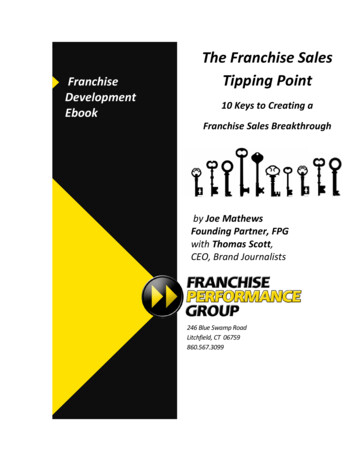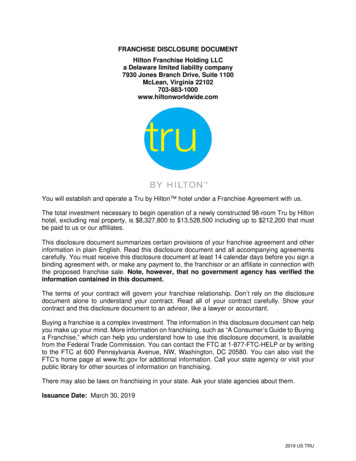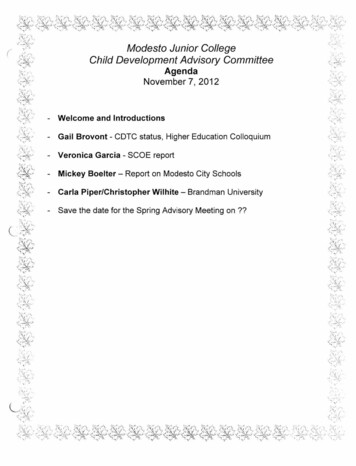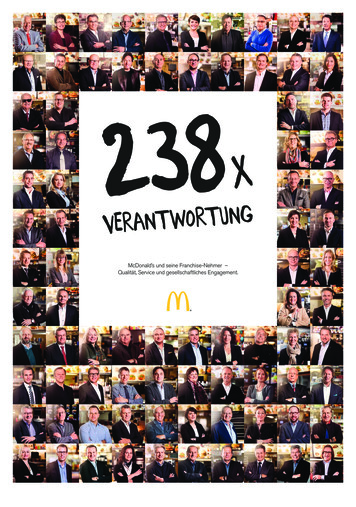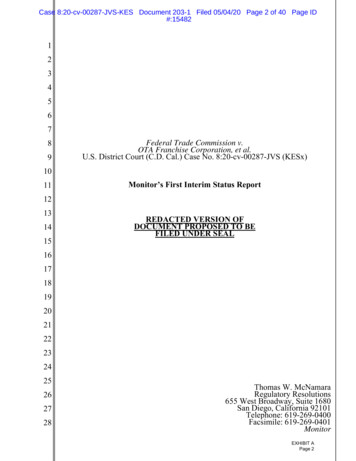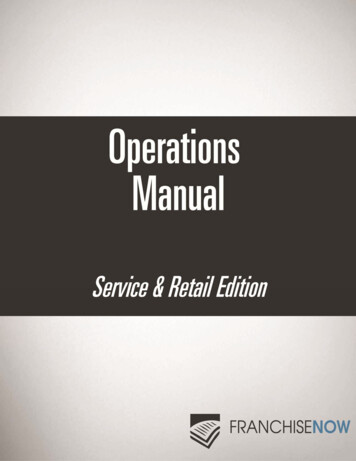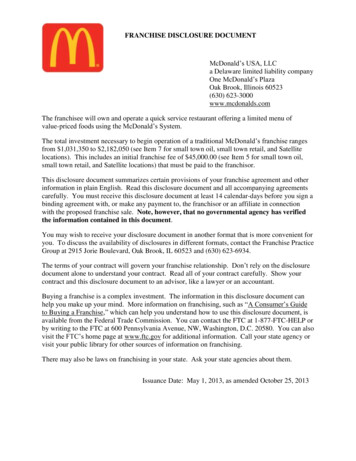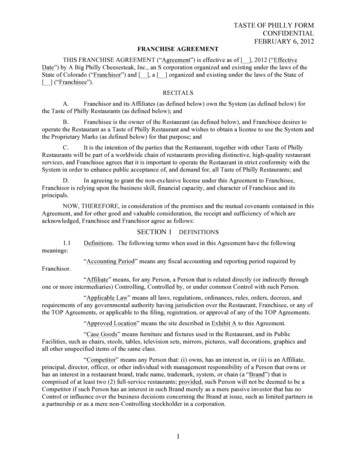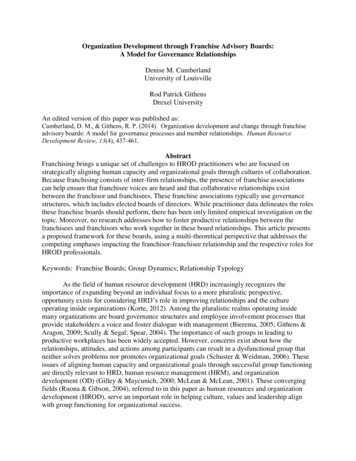
Transcription
Organization Development through Franchise Advisory Boards:A Model for Governance RelationshipsDenise M. CumberlandUniversity of LouisvilleRod Patrick GithensDrexel UniversityAn edited version of this paper was published as:Cumberland, D. M., & Githens, R. P. (2014). Organization development and change through franchiseadvisory boards: A model for governance processes and member relationships. Human ResourceDevelopment Review, 13(4), 437-461.AbstractFranchising brings a unique set of challenges to HROD practitioners who are focused onstrategically aligning human capacity and organizational goals through cultures of collaboration.Because franchising consists of inter-firm relationships, the presence of franchise associationscan help ensure that franchisee voices are heard and that collaborative relationships existbetween the franchisor and franchisees. These franchise associations typically use governancestructures, which includes elected boards of directors. While practitioner data delineates the rolesthese franchise boards should perform, there has been only limited empirical investigation on thetopic. Moreover, no research addresses how to foster productive relationships between thefranchisees and franchisors who work together in these board relationships. This article presentsa proposed framework for these boards, using a multi-theoretical perspective that addresses thecompeting emphases impacting the franchisor-franchisee relationship and the respective roles forHROD professionals.Keywords: Franchise Boards; Group Dynamics; Relationship TypologyAs the field of human resource development (HRD) increasingly recognizes theimportance of expanding beyond an individual focus to a more pluralistic perspective,opportunity exists for considering HRD’s role in improving relationships and the cultureoperating inside organizations (Korte, 2012). Among the pluralistic realms operating insidemany organizations are board governance structures and employee involvement processes thatprovide stakeholders a voice and foster dialogue with management (Bierema, 2005; Githens &Aragon, 2009; Scully & Segal; Spear, 2004). The importance of such groups in leading toproductive workplaces has been widely accepted. However, concerns exist about how therelationships, attitudes, and actions among participants can result in a dysfunctional group thatneither solves problems nor promotes organizational goals (Schuster & Weidman, 2006). Theseissues of aligning human capacity and organizational goals through successful group functioningare directly relevant to HRD, human resource management (HRM), and organizationdevelopment (OD) (Gilley & Maycunich, 2000; McLean & McLean, 2001). These convergingfields (Ruona & Gibson, 2004), referred to in this paper as human resources and organizationdevelopment (HROD), serve an important role in helping culture, values and leadership alignwith group functioning for organizational success.
As one setting for considering such issues, the franchising industry occupies a significantpresence in the areas of employability, economic generation, and human resource capability.Franchising arrangements occur when a corporation has a concept that it wants to expandthrough independent agents, who operate using the brand, products/services, and procedures ofthe franchisor (International Franchising Association, 2013). The franchisor grants a franchiseethe rights to operate one or more units in return for monthly payments, or what is referred to asroyalties. This 800 billion expanding sector in the United States (Haller, 2013) is one of theworld’s most accessible employers. In 2013, this business format accounted for over 8.2 millionjobs in the U.S., a gain of 2% versus 2012 (International Franchise Association, 2013). Franchisebusinesses continue to outpace growth in other business sectors, with over 750,000 franchiseestablishments operating in the United States (Haller, 2013).For HROD professionals that have a role in creating high-performance work systems(Galang, 1999), this unique business arrangement creates interesting challenges. The quasiindependent relationship between the franchisor and the franchisees requires a high level ofnurturing to encourage productive relationships (Truss, 2004). In franchise systems, franchiseesare entrepreneurs who exist within a large corporate structure. The front-line workers servingcustomers are typically not employees of the corporation (i.e., franchisor); instead, they areemployees hired by the franchisees, which have incorporated businesses. Such an environmentpresents a host of HROD issues, but raises particular challenges when considering how acorporation brings about system-wide change. Collaboration and shared decision making,foundational assumptions in much of the OD literature (e.g., Cummings & Worley, 2009;Schein, 1999), provide an option for organizations seeking such system-wide change.Additionally, when considering the prevention of problems, franchisors spend a good deal ofeffort working to prevent lawsuits or the premature exit of franchisees from the system. It is alose-lose-lose proposition when a franchise unit fails: the franchisee loses his or her investment,employees lose their jobs, and the franchisor loses royalties (Brox, 2010).Many industries are part of franchise systems, but common categories includerestaurants, lodging, automotive, fitness, education, real estate, maintenance, and businessservices. Understanding what detracts and enhances that relationship between franchisees andfranchisors been the subject of academic research (Cochet, Cormann, & Ehrmann, 2008;Kidwell, Nygaard, & Silkoset, 2007; Tikoo, 2005; Baucus, Baucus, & Human, 1996). Yet, oneof the understudied areas in franchising is the board of elected franchisees that share concerns,provide information and in some systems vote on organization proposals. While boardgovernance has been examined in corporations, nonprofits, professional associations and thepublic arena, there has been no literature that addresses franchise boardrooms.The dynamics of working through differences in achieving organizational goals createstensions between the different players that can result in conflict, of particular concern for HRODprofessionals (Korte, 2012). When a franchise relationship is dysfunctional there is far-reachingeffects on organizational health. Franchisees may resist training efforts, change initiatives, orrecommendations to address issues impacting the employees in their independent organizations.Corporate field employees who regularly interact with franchisees sometimes experience firsthand tension and sometimes experience hostile conditions that result in them moving to a newcompany. Furthermore, franchisees may begin to perceive a lack of support from the franchisorin a climate that is rife with conflict (Giddings, Weaven, Grade, & Frazer, 2011). On a moremacro level, the franchisor may have trouble recruiting new franchisees, resulting in slowerexpansion, thereby impacting the ability to fully establish the brand’s identity. The fostering of
positive relationships between franchisors and franchisees is similar to the importance offostering positive employee relations in other types of firms. In the case of franchiseorganizations, it is essential that these franchisees, who intimately know the day-to-day facets ofthe business, be engaged and providing continual feedback to improve the organization. HRODprofessionals working in franchise organizations address these challenges and opportunities on adaily basis.Studies conducted during the past decade have demonstrated the positive effects of intergroup collaboration on organizational performance (Iecovich, 2005). Dulewicz, MacMillan, andHerbert (1995) maintain that “an effective board is more than the sum of its individuals; it mustwork together effectively as a group, even as a team” (p. 8). While the HRD literature hasinvestigated group problem solving (Wolf, 1997) group processes (Qin, Smyrnious, Deng, 2012),generative groups (London, 2012), and the impact of teams (Russ-Eft, 1996), the HRODliterature overall has yet to focus on the nature of the relationships between franchisees andfranchisors. Since one of the core spheres of activity in HRD is organization development(Swanson & Holton, 2009), we need more knowledge about the factors that contribute or hinderfunctional relationships in this environment.Purpose of the PaperAs a major part of their role, HROD professionals serve as internal consultants and striveto help their organizations function optimally and avoid organizational dysfunction (Godkin &Allcorn, 2009). Given that research has shown participative communication and shareddecision-making are beneficial to franchise organizations (Weaven, Frazer, & Giddings, 2010),further understanding about how to ensure franchise boards function effectively is needed. Thepurpose of this paper is to provide a deductive model, drawn from the theoretical literature onboard governance that frames the type of relationship that is likely to operate in the boardroombased on the roles that the group emphasizes. The concepts developed in this article provide atheory-based typology for identifying the relationship that is likely to operate between electedfranchisee board members and franchisors when they intersect in the boardroom. Illuminatingthe relationship between the franchisor and franchisees on boards can help HROD professionalsin franchise organizations identify whether an intervention is needed to repair the relationship.Ultimately, a strong relationship between the franchisor and franchisees on these boards maylead to more unit growth, expansion of sales, and more employment opportunities, as franchiseesmay be more willing to expand their business when a culture of trust and respect is operating.Conversely, dysfunctional boards are likely to lead to simmering frustrations, resulting in aclimate of hostility and suspicion.Research Significance and ApproachHROD researchers and professionals benefit when they have typologies to help examinerelationships within and between groups. Limited empirical studies on franchise governingboards has made it difficult for those in HROD to fully understand how and why therelationships between franchisors and franchisee members of these groups become characterizedby hostility and distrust. These entities have not been examined in light of organizational theoriesthat may illuminate why certain types of behavior occur. This paper advances HROD theoryforward by offering a conceptual framework that aligns organizational theory with the type ofrelationship that operates on franchise boards.
The development of a typological framework that explains board relationships in light oforganizational theories is the goal. The paper provides an integrative literature review thatculminates in a proposed conceptual typology. The paper proceeds as follows. First, we providean overview of why franchise boards initially formed, how they have evolved and presentnormative expectations of the functions the boards perform based on practitioner and scholarlydata. Next, we examine the literature on board governance and applicable theoretical researchand empirical evidence associated with board roles. While franchising itself has been associatedwith multiple theoretical perspectives, franchise boards have not been associated with specifictheoretical linkages. We provide a theory-based framework for franchise boards that suggests aboard is either internally focused (agency theory) or externally focused (resource-dependent) andeither emphasizes the good of the organization (stewardship theory) or the good of themembership (stakeholder theory). We offer suggestions for future research, and conclude withimplications for research and for practice.Defining Franchise Association BoardsThe franchisee–franchisor relationship is interdependent. Each partner relies on andinfluences the other across multiple domains, including marketing, operations, finance, humanresources, and governance (Morrison, 1998). Unfortunately, in the case of franchising, thepossibility of intergroup conflict among members arises because franchisors and franchiseeshave a different lens for viewing solutions and it is rare for one group to belong to the othergroup. Furthermore, the power balance favors the franchisor, as it is the franchisor that retainsthe rights to the brand and it is the franchisor that specifies the terms of the contract (Chathoth &Olsen, 2003; Dant, Grunhagen, & Windsperger, 2011; Davis, 2012).The discrepancy in power between the franchisor and franchisee was the impetus for theformation of independent franchise associations (Darrin, Stadfeld, & Wulf, 1998; Karp, Norman,Safford, 1999). The first franchise associations came into existence in the 1970’s whenfranchisees coalesced formally to battle franchisors over perceived breaches of contractual rights(Luxenberg, 1986). By the end of the 1970s, there were over 40 independent franchiseassociations in the U.S. (Luxenberg, 1986).Over the years franchisors learned that it was wiser to recognize these entities and workwith them versus ignoring the franchise associations that sprang up (Karp, Normal & Stafford,1999; Nathan, 2008; Spandorf & Barkoff, 2003). Likewise, franchisees of these associationscame to recognize the need to collaborate with the franchisor (Gurnick & Wharton, 2000;Nathan, 2008; Spandorf & Barkoff, 2003). These associations are funded by dues paid bymembers, but in some cases the franchisor also contributes funds to the organization (Barkoff,Green-Kelly, 2006; Sniegowski, 2009). There is a lack of consistent data that identifies the totalnumber of franchise associations, but the International Association of Franchisees and Dealerslists 75 franchisee associations in the U.S. (Argyres & Bercovitz, 2013), while the AmericanAssociation of Franchise Dealers reports that 120 U.S. franchise systems have franchiseassociations (Emerson & Benoliel, 2014). Though limited, empirical research has identified thatwell-known brands, including Midas Muffler Dealerships, Holiday Inn Hotels, Dairy Queen,Subway, Burger King, Pizza Hut, Taco Bell, and Kentucky Fried Chicken restaurants all haveindependent franchise associations (Lawrence & Kaufmann, 2010). In addition to franchiseassociations, franchise organizations today may also have other forms of franchisee structuresthat promote collaboration, either taking the form of formal advisory councils or ad-hoc groupsof franchisees who meet regularly (Barkoff, Green-Kelly, 2006; Lawrence & Kaufmann, 2010;
Nathan, 2008; Shapiro & Zwisler, 1995). Practitioner data suggests that it is not uncommon forlarger franchise organizations to have both an independent association and a franchise advisorycouncil (Shapiro & Zwisler, 1995).While franchise associations are influential and have been addressed by franchiseattorneys and consultants, there is limited empirical data (Argyres & Bercovitz, 2013; Lawrence& Kaufmann, 2010). In a recent study, Argyres and Bercovitz (2013) found that the presence ofa franchise association improves franchisee bargaining power by allowing franchisees to winlonger-term contracts. Lawrence & Kaufmann (2010) found that franchise associations helpcreate a community framework of franchisees who become stewards of the brand. Both studieswere focused broadly on franchise associations membership overall, however, and neitherinvestigated the governance of these associations. Since it is the governing boards of thesefranchise associations that work closely with the franchisor, we address this gap in the literature.The governing body of the franchise association is the board of directors, which is electedby franchisees to pursue the objectives of the association for a pre-established term of office(Karp, Norman, & Stafford, 1999; Shapiro & Zwisler, 1995). The role of the franchisor on theboard varies. In some franchise systems, the franchisors’ help fund the association (Barkoff &Green-Kelly, 2006; Wulff & Trice, 1991). The franchisor may serve on the board in somesystems, or may meet regularly (as non-members) with the officers of the board. Somefranchisors may even attempt to ignore the association and its board (Barkoff & Green-Kelly,2006; Darrin, Stadfield, Wulff, 1998; Gurnick & Wharton, 2000; Spandorf & Barkoff, 2003).Franchisors who recognize their franchise associations include KFC, Pizza Hut, Taco Bell,Arby’s, Church’s Chicken, Fazoli’s, Burger King, Midas, Sylvan Learning Systems, FantasticSam’s, Curves and Taco John’s (Argyres & Bercovitz, 2013; Lawrence & Kaufmann, 2010;Spandorf & Barkoff, 2003).The limited empirical literature on franchise associations indicates that two of theprimary goals of these entities are representation of franchisee interests and development ofcommunity bonds (Argyres & Bercovitz, 2013; Lawrence & Kaufmann, 2010). Attorneypractitioners (Karp, Norman & Stafford, 1999; Barkoff and Green-Kelly, 2006) offer anexpanded list of functions that includes: An exchange of ideas between franchisees and between franchisor and franchisees A source of endorsement for initiatives being introduced to the system A safe communication forum to franchisees about changes proposed by the franchisorthat may not be beneficial to their interests More purchasing power through co-operative buying arrangements Representation of franchisee interests The bonding between the franchisee communityFrom an HROD perspective, we would expand this list to include collaborative development ofideas and consideration of changes proposed by both the franchisor and franchisee.Integration of Nonprofit Board Literature & Franchise LiteratureSimilar to professional and trade associations, franchise associations can register as nonprofit entities in most states (Wulff & Trice, 1991). While the empirical literature on franchiseassociation boards is silent, Lyons (1999) positions the boards of business and professionalassociations within the nonprofit sector. Likewise, Cornforth (2004) compares co-operatives andmutual associations to nonprofit boards. Parker (2007) argues that the nonprofit sectororganizations can be defined in multiple ways, including “organizations that are considered
nonprofit by law or custom, that are separate from government, self-governing and often ownedby their members, do not distribute any surpluses to members or those who control them, andattract voluntary membership and service, often through committee and board memberships” (p.1455). Scholars have made the case that these entities are comparable to nonprofits and userelevant literature from this arena to understand board governance (Friedman & Phillips, 2004;Parker, 2007).Organizational theorists Meyer and Rowan (1977) make the persuasive argument thatorganizations employ ritualized controls of credentials and solidarity. Governing boards offerone example of a formal ritualized structure that seeks to control and bring unity of purpose.Furthermore, new organizations are frequently modeled after old ones and managers seek modelsupon which to build (DiMaggio & Powell, 1985). This imitation is evidenced by the literature onnonprofit board roles being similar to the for-profit literature on board governance (Nicholson &Newton, 2010). Based on this argument, we suggest there is ubiquity with respect to governingfunctions performed by boards across sectors that can help us understand franchise boards. Weused nonprofit boards as a starting point to understand the theoretical underpinnings of boardactivities. A variety of competing organizational theories have been proposed to try tounderstand the role of boards in the nonprofit sector, including agency theory, stewardshiptheory, stakeholder theory, and resource dependency theory. A premise of this paper is that anumber of these theories can be usefully extended to franchise boards.Studies on nonprofit boards (Br
Keywords: Franchise Boards; Group Dynamics; Relationship Typology As the field of human resource development (HRD) increasingly recognizes the importance of expanding beyond an individual focus to a more plur
